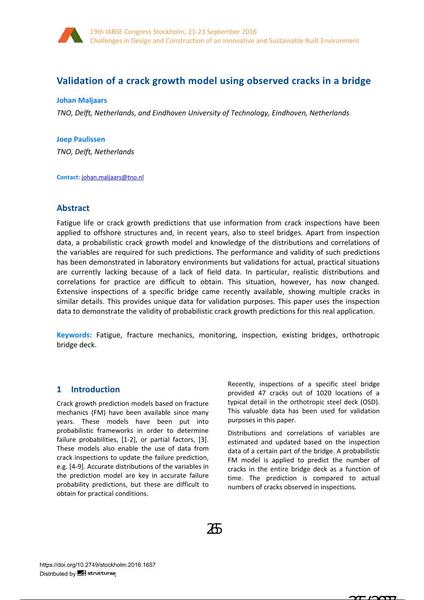Validation of a crack growth model using observed cracks in a bridge

|
|
|||||||||||
Bibliographic Details
| Author(s): |
Johan Maljaars
(TNO, Delft, Netherlands, and Eindhoven University of Technology, Eindhoven, Netherlands)
Joep Paulissen (TNO, Delft, Netherlands) |
||||
|---|---|---|---|---|---|
| Medium: | conference paper | ||||
| Language(s): | English | ||||
| Conference: | IABSE Congress: Challenges in Design and Construction of an Innovative and Sustainable Built Environment, Stockholm, Sweden, 21-23 September 2016 | ||||
| Published in: | IABSE Congress Stockholm, 2016 | ||||
|
|||||
| Page(s): | 265-272 | ||||
| Total no. of pages: | 8 | ||||
| Year: | 2016 | ||||
| DOI: | 10.2749/stockholm.2016.1657 | ||||
| Abstract: |
Fatigue life or crack growth predictions that use information from crack inspections have been applied to offshore structures and, in recent years, also to steel bridges. Apart from inspection data, a probabilistic crack growth model and knowledge of the distributions and correlations of the variables are required for such predictions. The performance and validity of such predictions has been demonstrated in laboratory environments but validations for actual, practical situations are currently lacking because of a lack of field data. In particular, realistic distributions and correlations for practice are difficult to obtain. This situation, however, has now changed. Extensive inspections of a specific bridge came recently available, showing multiple cracks in similar details. This provides unique data for validation purposes. This paper uses the inspection data to demonstrate the validity of probabilistic crack growth predictions for this real application. |
||||
| Keywords: |
fatigue orthotropic bridge deck fracture mechanics inspection existing bridges monitoring
|
||||
